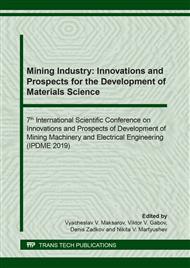[1]
L. Akulovich, L. Sergeev, V. Lebedev, Fundamentals of magnetic abrasive treatment of metal surfaces, BGATU, Minsk, 2012, 316 p.
Google Scholar
[2]
L. Akulovich, L. Sergeev, Technology and equipment of magnetic abrasive treatment of metal surfaces of various profiles, BGATU, Minsk, 2013, 372 p.
Google Scholar
[3]
U. Baron, Magnetic abrasive and magnetic treatment of products and cutting tools, Mashinostroenie, Leningrad, 1986, 176 p.
Google Scholar
[4]
F. Sakulevich, Fundamentals of magnetic-abrasive processing, Nauka i tehnika, Minsk, 1981, 328 p.
Google Scholar
[5]
F. Cheung, Z. Zhou, A. Geddam, K. Li, Cutting edge preparation using magnetic polishing and its influence on the perfomance of high-speed steel drills, J. of mater. processing technol. 208 (2008) 196–204.
DOI: 10.1016/j.jmatprotec.2007.12.108
Google Scholar
[6]
R. Gill, Effect of the process parameters on the surface roughness during magnetic abrasive finishing process on ferromagnetic stainless steel billets, Int. J. of Mechan. Engineer. and Technol. 4 (2013) 310–316.
Google Scholar
[7]
V. Krasnyy, A. Vazhenin, The assessment of wear resistance of thin-layer carbide coatings under vacuum arc deposition AER-Advances in Engineering Research, vol. 177, p.213–217, 2018, Int. Symp. on Engineer. and Earth Sci.
DOI: 10.2991/isees-18.2018.41
Google Scholar
[8]
V. Maksarov and A. Keksin, RU, Method of magnetic-abrasive finishing of working segments of thread tap. Patent 2 626 124 (2017) MPK B24B 31/112. no. 2016114202. published 21.07.2017. no. 21. 13.
Google Scholar
[9]
V. Maksarov, A. Keksin, Technological improvement of the quality of complex-profile surfaces by magnetic-abrasive polishing, Metalloobrabotka 1(97) (2017) 47–57.
Google Scholar
[10]
V. Maksarov, A. Keksin, Technology of magnetic-abrasive finishing of geometrically-complex products, IOP Conf. Ser. Materials Sci. and Engineer. 327 (2018).
DOI: 10.1088/1757-899x/327/4/042068
Google Scholar
[11]
V. Maksarov, J. Olt, Dynamic stabilization of machining process based on local metastability in controlled robotic systems of CNC machines, J. of Mining Instit. 226 (2017) 446–451.
Google Scholar
[12]
J. Olt, V. Maksarov, A. Keksin, Internal thread cutting process improvement based on cutting tools treatment by composite powders in a magnetic field, J. of Silicate Based and Composite Mater. 70(4) (2018) 128–131.
DOI: 10.14382/epitoanyag-jsbcm.2018.24
Google Scholar
[13]
K. Singh, V. Jain, V. Raghuram, Experimental investigations into forces acting during a magnetic abrasive finishing process, The Int. J. of Advanced Manufactur. Technol. 30(7–8) (2006) 652–662.
DOI: 10.1007/s00170-005-0118-6
Google Scholar
[14]
M. Vahdati, S. Rasoul, Evaluation of parameters affecting magnetic abrasive finishing on concave freeform surface of Al alloy via RSM Method, Advances in Materi. Sci. and Engineer. 14 (2016) 5256347.
DOI: 10.1155/2016/5256347
Google Scholar
[15]
V.F. Bezyazychnyi, M. Szcerek, M.L. Pervov et al., The Study of the Effect of Temperature on the Ability of Metals to Accumulate Energy During Their Plastic Deformation, J. of Mining Instit. 235 (2019) 55–59.
Google Scholar
[16]
N.V. Martyushev, Alignment of the microstructure of castings from the heterophase lead bronzes, Advanced Mater. Res. 880 (2014) 163–167.
DOI: 10.4028/www.scientific.net/amr.880.163
Google Scholar


